Multimode Fluoride Glass Optical Fiber
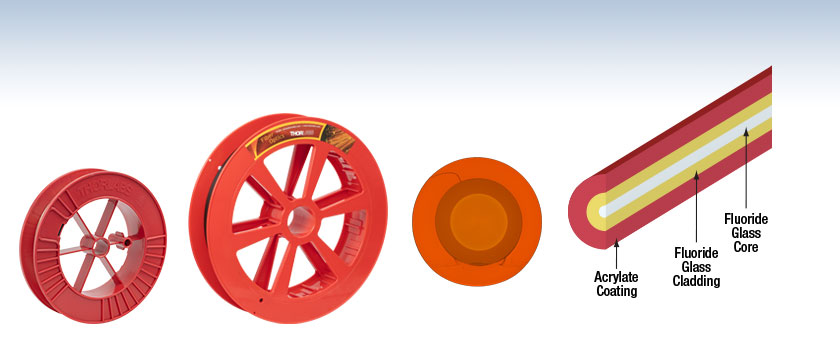
- Multimode ZBLAN or InF3 Fluoride Fiber Manufactured In-House
- Transmissive from the UV to Mid-IR
- Dual-Clad Fiber for High-Power Applications Available
Ø200 µm Core ZBLAN Fiber End Face
Fluoride Fiber Cross Section
(Not to Scale)
Spools for Multimode Fluoride Fibers

Please Wait
Applications
- Spectroscopy
- Fiber Lasers
- Supercontinuum Light Sources
- Environmental Monitoring
- Surgical Lasers
- Chemical Sensing
- IR Imaging
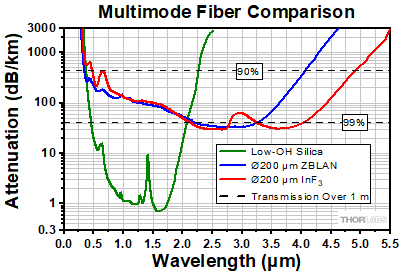
Click to Enlarge
Click for Raw Data
Compared to standard silica glass fibers, Thorlabs' multimode
fluoride fibers are transmissive at much longer wavelengths.
Features
- Fluoride Glass Fibers Manufactured at Thorlabs' Fiber
Draw Facility- Fluorozirconate (ZBLAN)† for 285 nm - 4.5 µm
- Fluoroindate (InF3) for 310 nm - 5.5 µm
- Core Diameters from 50 µm to 600 µm
- Dual-Clad Multimode Fibers for High-Power Applications Available
- World-Class Attenuation, Strength, and Geometry Control
- Custom Core Sizes and Fiber Geometries Available by Contacting techsales@thorlabs.com
Thorlabs' multimode fluoride glass fibers are manufactured in-house and have world-class purity, precision, and strength. For more information about fluoride glass and our manufacturing process, see the Manufacturing tab and our main fluoride fiber web presentation.
Fluoride fibers offer low attenuation in the mid-IR wavelength range, aided by an extremely low hydroxyl ion (OH) content. Our multimode fibers are made from ZBLAN† (fluorozirconate) glass, which is highly transmissive over the 285 nm - 4.1 µm range; or InF3 (fluoroindate) glass, which is highly transmissive over the 310 nm - 5.5 µm range. The graph to the right shows how the wavelength-dependent attenuation compares to that of a standard silica glass fiber.
Our InF3 fibers are available with a polymer second cladding to improve their operation in high-power applications. See the Dual-Clad Fiber tab for details.
The refractive index of fluoride glass is near that of silica. As a result, optical fibers manufactured using fluoride glass exhibit low return losses and Fresnel reflections at both fiber-air and fiber-silica interfaces. Graphs of refractive index, numerical aperture (NA), and attenuation can be seen in the Graphs tab.
Since fluoride glass is softer than standard silica glass, extra care should be taken while cleaning and handling. See the Handling tab for suggested procedures. To avoid fiber overlap on the spool, the fluoride fibers will ship on one of two spools with a 0.5 m or 1 m circumference, depending on the core size and length of the fiber.
Thorlabs also manufactures single mode fluoride fiber and a selection of fluoride fiber components. See the selection guide below for links the main web presentation for each type of component we offer.
† ZBLAN and ZrF4 are used interchangeably to refer to fluorozirconate glass.
Custom Fluoride Fiber
If our standard offerings do not meet your needs, please contact us to discuss customization and potential fiber draws. Some of the many customization options we provide for fluoride fibers include:
- Hand-Selected Extra-Low-Loss Fibers to Meet Strict Attenuation Requirements
- Custom Core and Cladding Geometries
- Dual-Polymer Claddings Available
- Increased Power Handling Capabilities
Our dual-clad multimode fluoride fibers are not currently available from stock, but are available by contacting techsales@thorlabs.com. Standard fibers can be ordered using their
Fiber Identification #s (see the Specs tab for details). If our standard fibers do not fit your needs, custom fibers can be requested as well.
Fluoride Fibers and Components |
|||
 |
 |
 |
 |
 |
 |
 |
 |
Our dual-clad multimode fluoride fibers are not currently available from stock, but are available by contacting techsales@thorlabs.com. Standard fibers can be ordered using their
Fiber Identification #s (see the Specs tab for details). If our standard fibers do not fit your needs, custom fibers can be requested as well.
This tab contains plots of the typical attenuation, numerical aperture, and core and cladding refractive indices of our multimode fluoride fibers as a function of wavelength. Variations in these properties can occur between fiber draws. For more information on the material properties of fluoride glasses, please see the Graphs tab of our fluoride fiber overview page. Please contact Tech Sales to discuss whether these fibers are appropriate for your application.
Attenuation
These graphs show measured attenuation of our multimode fluoride fibers, from several independent fiber runs. The blue shaded regions denote the wavelength range with guaranteed attenuation performance for each fiber, which is represented by the dashed line.
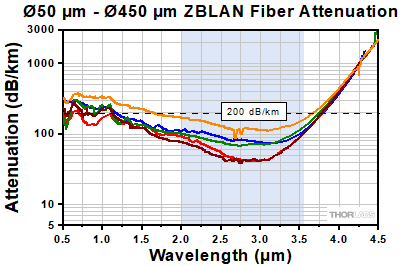 Click to Enlarge
Click to EnlargeClick for Raw Data
This data was taken from five independent runs of Ø450 μm core ZBLAN fiber, and is representative of all ZBLAN fibers with cores from Ø50 μm to Ø450 μm.
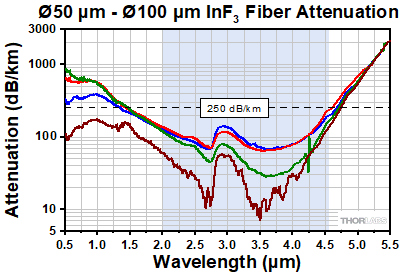 Click to Enlarge
Click to EnlargeClick for Raw Data
This data was taken from four independent runs of Ø100 μm core InF3 fiber, and is representative of InF3 fibers with cores from Ø50 µm to Ø100 µm.
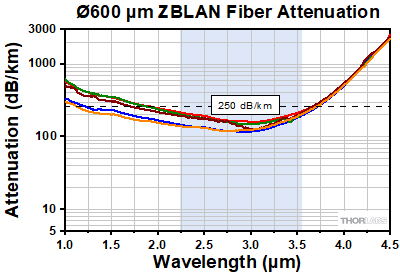 Click to Enlarge
Click to EnlargeClick for Raw Data
This data was taken from five independent runs of Ø600 μm core ZBLAN fiber.
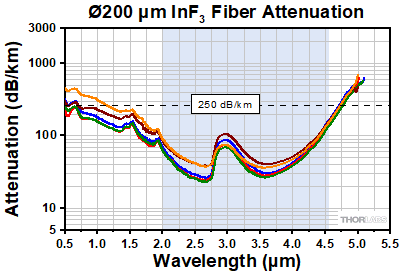 Click to Enlarge
Click to EnlargeClick for Raw Data
This data was taken from five independent runs of Ø200 μm core InF3 fiber.
Numerical Aperture
These graphs show the typical numerical aperture (NA) of our multimode fluoride fibers, calculated from the core and cladding refractive indices.
Refractive Indices
These graphs show the typical refractive indices of the core and cladding of our single mode fluoride fibers. The graphed data was obtained by fitting the Sellmeier equation to measured data. The Sellmeier equation and best-fit parameters for each fiber's core and cladding can be seen below each graph.

Sellmeier Equation
| ZBLAN Sellmeier Coefficients | ||
|---|---|---|
| Coefficient | Core | Cladding |
| u0 | 0.5463 | 0.705674 |
| u1 | 0.7566 | 0.515736 |
| u2 | 1.782 | 2.204519 |
| u3 | 0.000 | 0.087503 |
| u4 | 0.116 | 0.087505 |
| u5 | 21.263 | 23.80739 |
| A | 0.9562 | 1 |
| InF3 Sellmeier Coefficients | ||
|---|---|---|
| Coefficient | Core | Cladding |
| u0 | 0.47627338 | 0.68462594 |
| u1 | 0.76936893 | 0.4952746 |
| u2 | 5.01835497 | 1.4841315 |
| u3 | 0.0179549 | 0.0680833 |
| u4 | 0.11865093 | 0.11054856 |
| u5 | 43.64545759 | 24.4391868 |
| A | 1 | 1 |
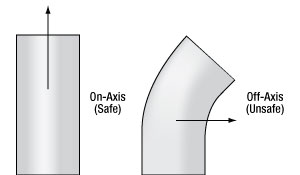
Click to Enlarge
This diagram compares on-axis tension, which can be safely applied, to off-axis tension, which can induce unsafe curvature and damage the fiber.
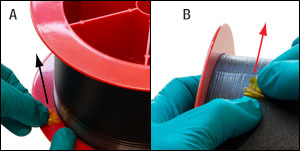
Click to Enlarge
The recommended procedure for removing tape from the bare fiber spools is shown in this image. The tape should be pulled parallel to the fiber when removing, while the other hand applies gentle force to stabilize the fiber.
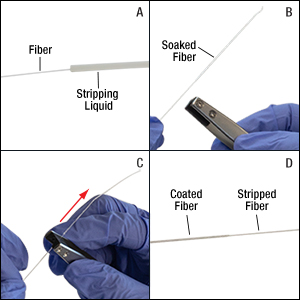
Click to Enlarge
These images depict the recommended stripping procedure. A: Immerse the target fiber secion in stripping liquid.
B-C: Gently pinch the base of the soaked section with FSGT tweezers and pull toward the end of the fiber.
D: The coating should slide off, leaving a stripped section.
The material properties of fluoride glass differ from those of silica glass. This tab details recommended handling procedures for our fluoride fibers and patch cables.
Safety and Disposal
ZBLAN and InF3 glasses may present health risks. Information about the composition of our fluoride fibers is available from Tech Support upon request. When handling bare, stripped fluoride fiber, chemically resistant gloves such as our nitrile gloves should always be worn. Fiber shards generated from cleaving should be disposed of in a sharps container such as our FTDU fiber optic disposal unit.
Thorlabs will accept and dispose of any fluoride fiber or filled disposal units that you wish to discard. Please contact Tech Support before returning fiber or filled disposal units. If you wish to dispose of fiber locally, please follow all applicable local laws and regulations.
Storage
Because fluoride glass is softer than silica glass, exposed end faces are easily scratched during storage, and care should be taken to ensure that they are not exposed to mechanical abrasion. Storage under normal lab temperatures and humidities will not affect the integrity of the fiber. Prolonged, direct contact with liquid water or water vapor should be avoided.
Bending and Tension
Fluoride fiber is strong in tension, but can break easily if forces are applied off-axis or if it is bent to a small radius. These fibers should never be bent to smaller than their short-term bend radii. Moderate on-axis forces can be safely applied to the fiber, such as tension applied during spooling. The diagram to the right demonstrates safe on-axis tension and unsafe off-asix tension.
Our bare fluoride fibers ship on a spool, with their ends taped to the spool body. When removing the fiber, the tape should be pulled parallel to the fiber, as shown in the image to the top right.
For protection, our fluoride patch cables are jacketed with PVDF furcation tubing or stainless steel tubing that is stiffer than the jackets used in typical patch cables. As long as the jacket is not forced to bend below its specified minimum radius, the fiber will remain intact. For out patch cables with PVDF jackets, the tubing will become discolored if the bending limit is exceeded. Our patch cables with stainless steel tubing are designed so that the tubing mechanically limits the fiber to be unable to bend below its minimum radius.
Stripping
Fluoride fibers are susceptible to damage when conventional mechanical stripping techniques are used, owing to the softness of the glass. Our FSGT Coating Stripping Tweezers can be used along with a chemical stripping agent to effectively strip these fibers without scratching or nicking the cladding.
To strip a fiber, the coating should first be exposed to a stripping liquid such as a paint stripper for three to five minutes. Placing the stripping liquid in a long vessel such as a syringe with a long tip is recommended to increase ease of application. If using a gel-type stripper, it can be applied manually to the exterior of the fiber. Note that the required soaking time will depend on the particuar stripping agent being used as well as the chemical composition of the coating. For example, if a dicholomethane (DCM) based stripping liquid is used, the required time may be shorter.
The coating on the section of the fiber soaked in stripping liquid will visibly swell, as seen in section B of the image to the right. A pair of FSGT tweezers can then be used to gently pinch the fiber in the soaked section, and pull toward the end of the fiber. Care should be taken to ensure that only moderate pressure is applied, or else the fiber may break. The soaked coating should slide off the end of the fiber, leaving the cladding exposed. If residue remains on the stripped section, it can be cleaned as detailed below.
Refer to any safety documentation for the chemical stripping agent before use.
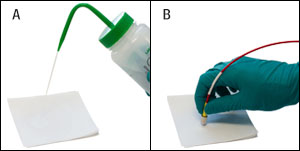
Click to Enlarge
These images depict the recommended procedure for cleaning end faces with a solvent.
A: Wet a stack of five or more TCW604 wipes with an appropriate solvent (see the text for examples).
B: Gently pass the fiber end face across the wet wipe.
Cleaning
Because fluoride glass is soft, end faces and stripped sections of our fluoride fibers and patch cables can be easily scratched during cleaning. If particulates are present on the glass surface, first try to remove them using compressed air. If compressed air is insufficient, then an appropriate solvent can be used with our TCW604 TechniCloth®† Lint-Free Wipes to clean the tip, as shown in the image to the left. Methanol and isopropanol are examples of appropriate solvents, while acetone is unsuitable. Wiping with a dry cloth is not recommended as it may scratch the surface.
Please note that Kimwipes®†† are extremely likely to scratch the fiber tip and should not be used.
Cleaving
Our fluoride fibers can be cleaved using a tension-and-scribe cleaver such as our Vytran® LDC401 large-diameter fiber cleaver. Note that cleaving these fibers may generate shards. Safety glasses and chemically resistant gloves should always be worn when cleaving.
†TechniCloth® is a registered trademark of the Illinois Tool Works, Inc. Corporation.
††Kimwipes® is a registered trademark of the Kimberly-Clark Corporation.
View our recorded webinar, in which we highlight our manufacturing techniques, the history of fluoride fiber R&D, and the state of fluoride fiber technology today and in the future.
Thorlabs manufactures ZBLAN zirconium fluoride (ZrF4) and indium fluoride (InF3) fibers at our vertically integrated fiber draw facility. The facility handles raw materials, glass preforms, fiber draw, and patch cable production, all in the same location. By controlling the process from start to finish, Thorlabs can ensure fibers consistently meet world-class specifications, including low attenuation, high mechanical strength, and precise geometry control.
The facility, located in Newton, NJ, USA, is well-equipped for high-volume manufacturing and is capable of producing many kilometers of fiber with consistent performance. In addition, because the fiber stays within Thorlabs' facilities from start to finish, the manufacturing process can be adjusted to accommodate unique custom orders or R&D needs.
Fluoride Characteristics
Fluoride fibers are ideal for transmission in the mid-IR wavelength range, and Thorlabs' fibers feature low attenuation over this range as a result of stringent manufacturing processes yielding an extremely low hydroxyl ion (OH) content. Fluoride fibers also have lower refractive indices and lower chromatic dispersion when compared to other fibers that offer transmission in the mid-IR range, such as chalcogenide glass fibers. Thorlabs' tightly controlled processes mitigate scattering and point defects in the fiber, as well as eliminate micro-crystallization in the glass matrix.
Fluoride Fiber Characterization and Testing
In addition to manufacturing fiber, Thorlabs offers testing and characterization services for our fiber products. We precisely measure the properties of each drawn fiber to ensure that it meets our high standards of quality. Extensive testing also provides feedback for our fiber draw team, enabling tight control of each step in the manufacturing process. Customers can request custom testing of any Thorlabs-manufactured fiber, which is then provided with the shipped fiber. Testing of third-party fiber samples provided by customers is also available upon request.
Available tests and services include:
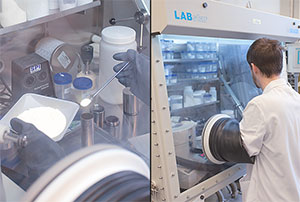
Click to Enlarge
A Thorlabs engineer mixes raw materials in our fluoride glass fabrication facility.
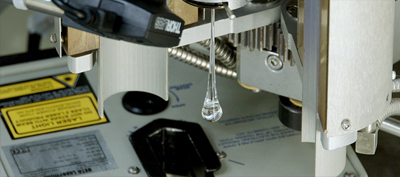
Click to Enlarge
A Glass Drop During the Fiber Draw Process
- Spectral Attenuation Measurement
- UV / Visible / NIR / MIR Wavelength Range
- SM or MM Fiber and Bulk Glass
- SM Fiber Cutoff Wavelength Measurement
- Fiber NA Measurement
- Fiber Glass / Coating Geometry Measurement
with Sub-µm Accuracy - MIR High-Power Screening for MM Fibers
- Fiber Tensile Strength Testing
- Defect / Break Analysis
- Degree of Cure Testing for Fiber Coatings
Request testing for Thorlabs or third-party fibers by
contacting Tech Sales.
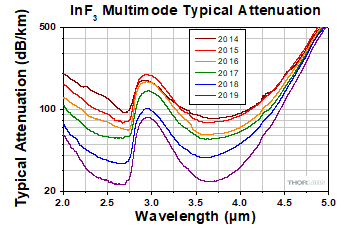
Click to Enlarge
These graphs show Thorlabs' steady improvement in the average attenuation of all fiber draws during the given year.
Technical Team
Thorlabs' team of MIR fiber researchers and engineers has many years of experience in fluoride glass research and development, production, and fiber draw. Their knowledge and expertise have resulted in consistent improvement in the quality of our fluoride fiber. See the graphs to the left for the progression of our fluoride fiber performance.
Custom Fluoride Fiber and Patch Cables
If our standard offerings do not meet your needs, please contact Tech Support to discuss customization and potential fiber draws. Some of the many customization options we provide for fluoride fibers and patch cables include:
Bare Fiber
|
Patch Cables
|
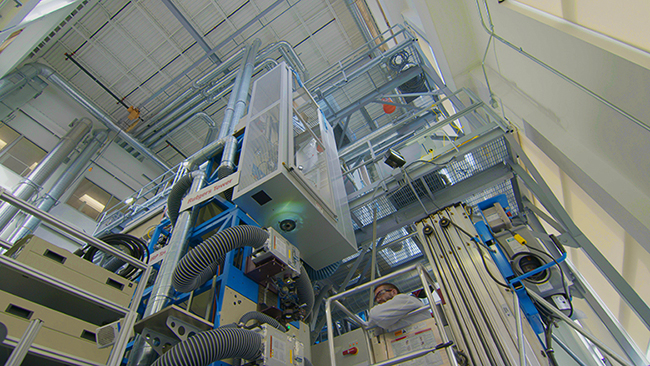
Click to Enlarge
Thorlabs' Fiber Draw Tower
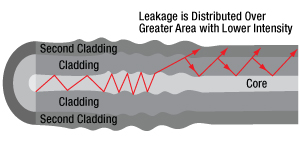
Click to Enlarge
Microbend Loss in Dual-Clad Fiber: Light that leaks out of the core propagates within the first cladding. The light exits the fiber over a greater area with lower intensity, avoiding damage to the fiber.
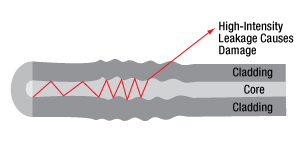
Click to Enlarge
Microbend Loss in Standard Fiber: Light that leaks out at a single spot has high intensity and can damage the fiber.
Multimode Dual-Clad Fiber for High Power
- Second Cladding Creates Additional Waveguide Layer
- Reduces Risk of Damage Due to Light Leakage
- Ideal for High Power
- Contact Tech Sales to Order
Our unique dual-clad fiber is designed for delivery of high power beams. Light propagates in the core of the fiber due to total internal reflection upon hitting the interface with the cladding. In a perfect fiber, the light is reflected completely at each point and propagates through the fiber core. However, certain imperfections can cause light to exit the core and leak into the cladding; such imperfections include bends in the fiber cable, microbends in the layers of the fiber, and defects.
In a single-clad fiber, the light may leak out of the fiber at a single spot. This high-intensity spot can easily burn or otherwise damage the fiber. In contrast, double-clad fiber uses a second cladding as a light guide to distribute some of the light leakage along a length of the fiber. This significantly reduces the risk of damage, as the intensity of the leakage is greatly reduced. The images above illustrate the effect of the second cladding in preventing damage.
See the Specs tab for specifications for our dual-clad fiber, or contact Tech Support to discuss custom dual-clad fiber options.
| Posted Comments: | |
Michael Montoya
(posted 2024-06-28 17:48:45.33) Hello,
Do you have attenuation plots below 500nm for FZM fiber?
Thanks! cdolbashian
(posted 2024-07-12 02:15:27.0) Thank you for reaching out to us with this request. We do indeed have this data on the product page. We share this in the caption of the attenuation plot on the overview tab. I have reached out to you directly to share this information more clearly. |

Due to the fluoride fiber manufacturing process, long continuous fibers may not be immediately available. If your order is over the threshold for a given fiber, you may be shipped multiple shorter fibers. Please note that each fiber also has a maxmium continuous spool length and orders longer than this will be subject to a surcharge. For information on these lengths regarding a specific fiber, please see the Specs tab. If you require a longer continuous fiber, please contact techsales@thorlabs.com.
Fibers with specific attenuation requirements, as well as bend radius proof testing, can also be requested. Please note that our fluoride fibers will typically ship within two days,
but special orders may be subject to longer lead times.
| Item # | Fiber Type | Wavelength Rangea |
Typical Attenuationb,c |
Maximum Attenuationb |
NA | Core Diameter |
Cladding Diameter |
Coating Diameter |
Bend Radius (Short Termd/ Long Termd,e) |
Operating Temparature |
|---|---|---|---|---|---|---|---|---|---|---|
| FZM05020 | Fluorozirconate (ZBLAN)f |
285 nm - 4.5 µm | 150 dB/km @ 2.5 µm |
≤200 dB/km (for 2.0 - 3.6 µm) |
0.20 ± 0.02 @ 2.0 µm |
50 ± 4 µm | 140 ± 2.5 µm | 265 ± 20 µm | ≥20 mm / ≥35 mm | -55 °C to 90 °C |
| FZM10020 | 100 ± 7 µm | 192 ± 2.5 µm | 275 ± 25 µm | ≥25 mm / ≥50 mm | ||||||
| FZM20020 | 200 ± 10 µm | 290 ± 10 µm | 430 ± 25 µm | ≥40 mm / ≥80 mm | ||||||
| FZM45020 | 450 ± 15 µm | 540 ± 15 µm | 650 ± 25 µm | ≥50 mm / ≥125 mm | ||||||
| FZM60020 | 200 dB/km @ 2.5 µm |
≤250 dB/km (for 2.0 - 3.6 µm) |
600 ± 20 µm | 690 ± 20 µm | 800 ± 40 µm | ≥75 mm / ≥160 mm |

Due to the fluoride fiber manufacturing process, long continuous fibers may not be immediately available. If your order is over the threshold for a given fiber, you may be shipped multiple shorter fibers. Please note that each fiber also has a maxmium continuous spool length and orders longer than this will be subject to a surcharge. For information on these lengths regarding a specific fiber, please see the Specs tab. If you require a longer continuous fiber, please contact techsales@thorlabs.com.
Fibers with specific attenuation requirements, as well as bend radius proof testing, can also be requested. Please note that our fluoride fibers will typically ship within two days,
but special orders may be subject to longer lead times.
| Item # | Fiber Type | Wavelength Rangea |
Typical Attenuationb,c |
Maximum Attenuationb |
NA | Core Diameter |
Cladding Diameter |
Coating Diameter |
Bend Radius (Short Termd/ Long Termd,e) |
Operating Temperature |
|---|---|---|---|---|---|---|---|---|---|---|
| FFM05026 | Fluoroindate (InF3) |
310 nm - 5.5 µm | 100 dB/km (at 2.5 µm and 3.6 µm) |
≤250 dB/km (for 2.0 - 4.6 µm) |
0.26 ± 0.02 @ 2.0 µm |
50 ± 2.0 µm | 140 ± 2.5 µm | 265 ± 20 µm | ≥20 mm / ≥35 mm | -55 °C to 90 °C |
| FFM10026 | 100 ± 2.0 µm | 192 ± 2.5 µm | 280 ± 15 µm | ≥25 mm / ≥50 mm | ||||||
| FFM20026 | 200 ± 10 µm | 290 ± 10 µm | 430 ± 25 µm | ≥40 mm / ≥80 mm |
 Products Home
Products Home












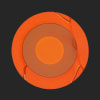

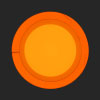






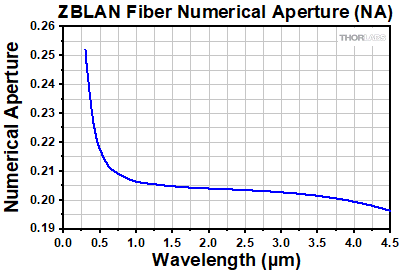 Click to Enlarge
Click to Enlarge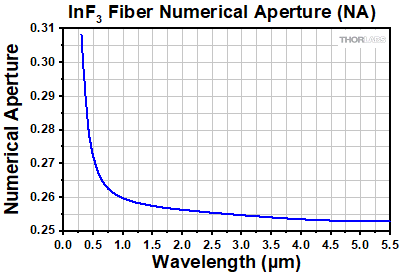 Click to Enlarge
Click to Enlarge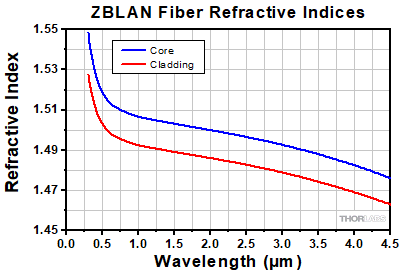
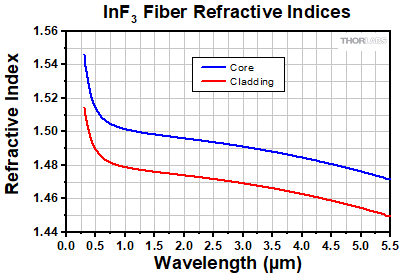

 Multimode Fiber
Multimode Fiber